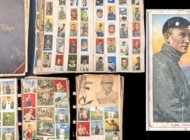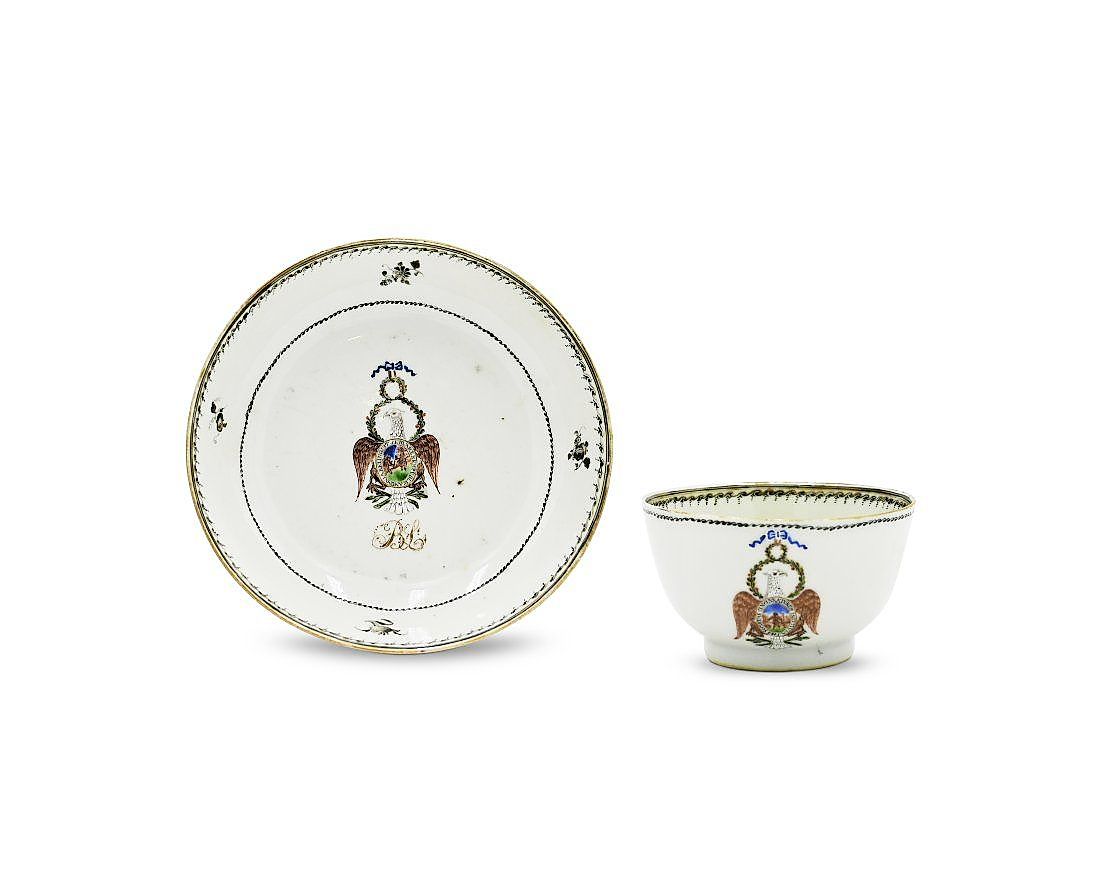
Bearing the arms of the Society of the Cincinnati, this tea bowl and saucer from a service made for General Benjamin Lincoln was the most expensive item in the sale, earning $62,500.
Review & Onsite Photos by Rick Russack; Catalog Photos Courtesy Grogan & Co
BOSTON — Grogan’s August 16 sale presented well over 1,500 objects in 483 lots of Chinese export porcelain and China trade silver, furniture and paintings. The sale was 100 percent sold and earned $1,112,000. Prices ranged from $65 to $62,500. Buyers participated from the United States as well as from Europe and Asia. The collection was assembled over a 40-year period by brothers Vartan ‘Van’ and Armen Ghugasian, both of whom have passed away. They were familiar faces in the auction galleries and antiques shows of New England and New York and their search extended far beyond. The depth of their knowledge and passion for the subject were reflected in the breadth of the collection, which, in addition to wares made for the American market, included numerous examples of rare Chinese export porcelains made for the Armenian market, which was the homeland of their family, as well as wares made for the English, Portuguese, Spanish, Russian and Dutch markets. Armen was a successful photographer in the Boston area while Van was a successful dentist with an office in Watertown.
There were two highly desirable lots in the sale bearing the arms of the Society Of The Cincinnati, with one drawing the highest price of the auction. The Society is one of the United State’s oldest patriotic and hereditary organizations, founded in 1783 by officers of the Continental Army who served together in the American Revolution. The Society’s website states “hereditary members of the Society are qualified male descendants of commissioned officers who served in the Continental Army or Navy, or of officers of the French royal forces who served in America during the Revolutionary War. George Washington was the first president general of the Society. The Continental army’s chief of artillery, Henry Knox, was the chief author of the Institution.” A few of the original members of the Society had tea sets or dinner services made in China, incorporating the arms of the Society in their decoration. These pieces are among the rarest Chinese export porcelain made for the American market, so it is not surprising that the highest price of this sale was earned by such a piece: a tea bowl and saucer from a service made for Benjamin Lincoln, circa 1790, bearing the arms of the Society, sold for $62,500. Lincoln was a Major General in the Continental Army, who although having significant defeats in his career, he was the one who accepted the surrender of the British Army, commanded by Lord Cornwallis at Yorktown, ending the war. He is immortalized in John Trumbull’s classic painting “The Surrender of Cornwallis,” which still hangs in the US Capitol building.
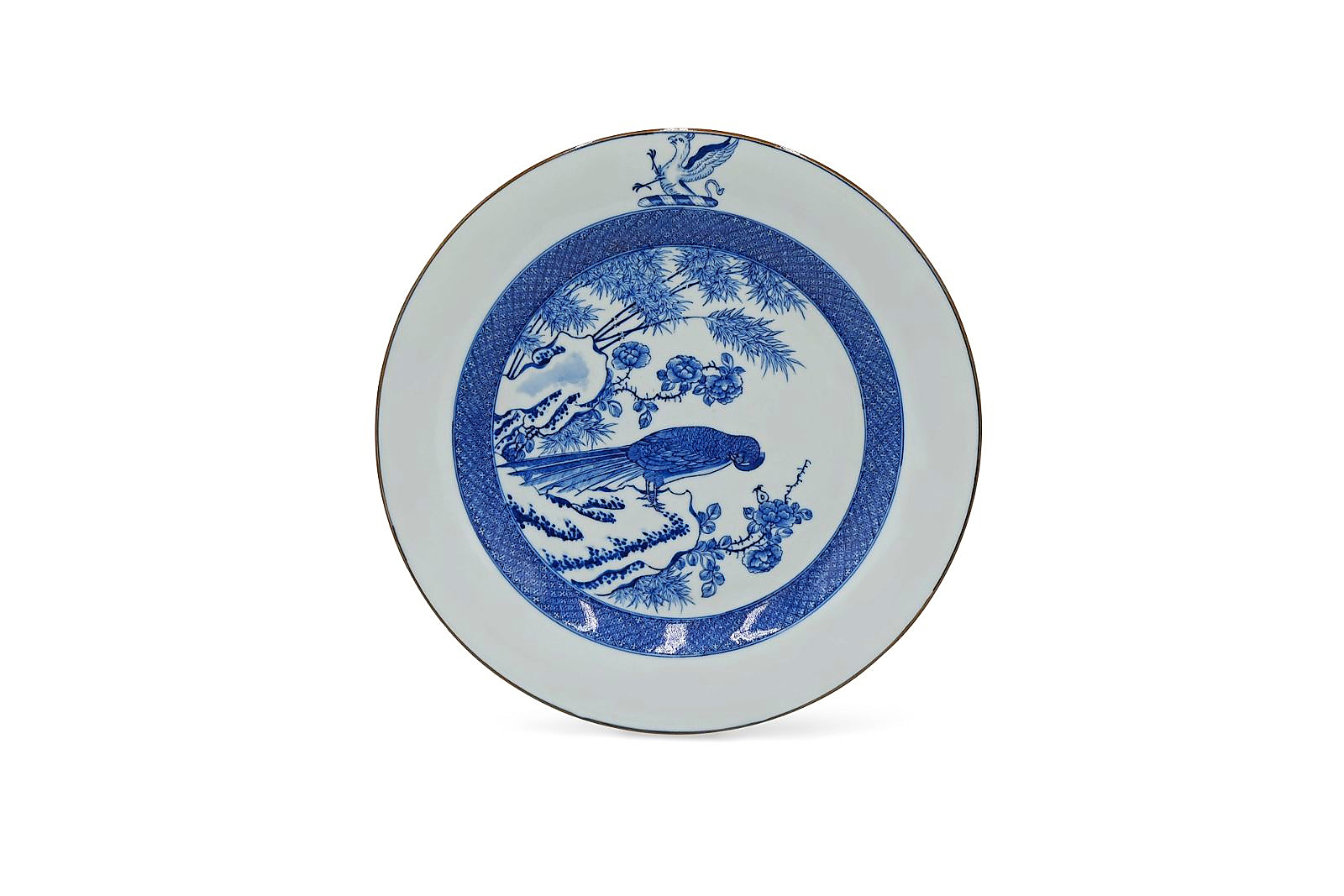
A circa 1731 armorial plate, bearing the Crest Of Peers with a phoenix, realized $5,312.
The other lot with the arms of the Society — a circa 1790 covered broth bowl with two handles — from a service made for Samuel Shaw, realized $18,750. He was a major during the war and Washington named him America’s first consul to China, where he lived from 1786 to 1789.
The sale began with armorial plates made for the British market. The first lot of the sale, a pair of circa 1725 armorial plates bearing the arms of Mertins impaling Peck, earned $2,500, well above the estimate and setting the tone for the rest of the sale. Sir George Mertins was Lord Mayor of London in 1725; his son married Elizabeth Peck and it is likely that these plates were made for a service marking that event. A circa 1724 plate with the arms of Duncombe quartering Cornwallis and impaling Verney brought $1,300. A pair of circa 1730 plates, bearing the arms of Izod of Kilkenny brought $3,250. They were decorated with arms depicting six jaguar heads within diamonds and a floral border.
American armorial examples included a sauce boat and dish from the service of Elias Boudinot IV, circa 1790. Boudinot was a delegate to the Continental Congress from New Jersey in 1777. As president of that body in 1782-83, he signed the provisional peace treaty with Britain. These two pieces sold for $6,875.
Two circa 1750 plates from the service of Samuel Vaughan, with his arms, earned $4,687.
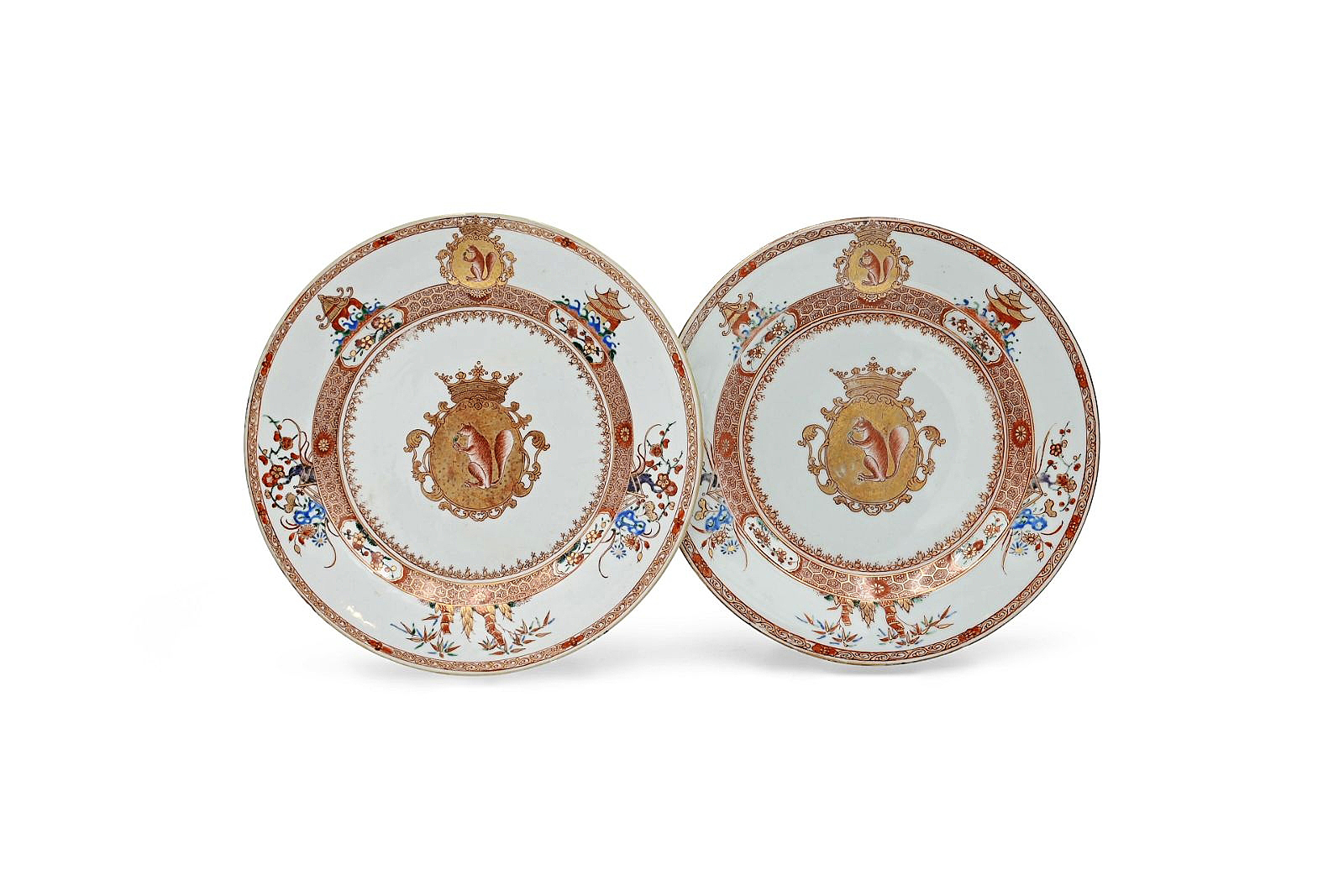
Made for the Dutch trade, a lot of 12 armorial plates, circa 1730-1735, bearing the arms of Sichterman of Groningen, realized $9,375.
The Ghugasian brothers, having been of Armenian descent, especially sought out examples of Chinese export porcelain made for the Armenian market. These are few and far between, and the 10 examples in this sale not only brought some of the highest prices in the sale, they drew international bidding. Having said that, all but one piece went to a collector of Armenian descent living in the United States. Leading this highly specialized group and selling for $23,750 was a lot of four hot-water plates, decorated with a spearhead gilt border and detailed blue geometric designs. Each were 11 inches in diameter, dated 1833, and bore the Cyrillic monogram “A.Y.A.” Two lots from the same service sold; a covered sauce tureen brought $21,250, while a footed well and tree platter went out at $15,000. A dated 1794 covered sugar bowl, also made for the Armenian market, sold for $15,000, while a 9-inch armorial plate with a central image of two crowned lions and a dove, bearing a Cyrillic monogram “V.M.E.” encased in a heart, sold for $11,875.
The Armenian-commissioned porcelains were made in the town of Jingdezhen, in the Jiangxi province in southeast China and were decorated with enamels in Canton according to “Armenian Patrons for Chinese Commodities: Trade Networks and Cultural Exchange across Asia” as written by George Manginis for the Gingko Library Art Series (2016).
The collectors sought unusual and rare wares. An atypical, circa 1800, coffee cup and saucer from a “sample set” that was exported from China to allow European and American purchasers to select from eight stock borders earned $11,050. There was a small circular covered box bearing the Royal arms of Spain with a portrait of either King Charles III or IV, which realized $4,375. A pair of reticulated dishes bearing the arms of Catherine the Great of Russia, circa 1785, realized $3,125.
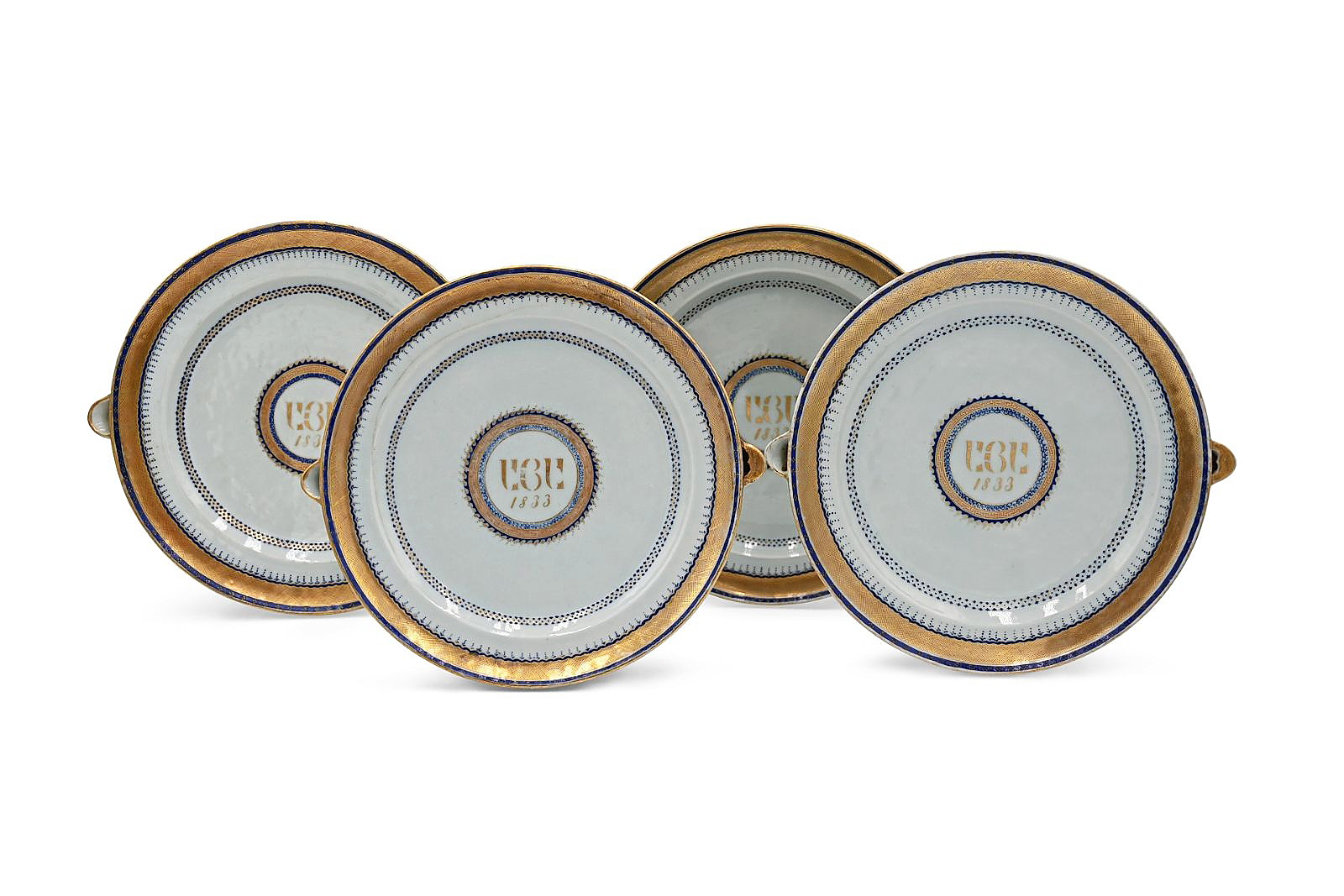
Finishing at $23,750, this lot of four hot-water plates was the highest priced lot of the Armenian offerings in the sale. Each bore the Cyrillic monogram “A.Y.A” and the date “1833.”
There were about 10 lots of Dutch armorial pieces, including a set of 12 armorial plates bearing the arms of Sichterman of Groningen, circa 1730-35, which brought $9,375. Eight lots included porcelains made for the Portuguese market, including an armorial plate and bowl, bearing the arms of D. Antonio Sao Jose of Castro, circa 1810, which brought $6,875. They were decorated with gilt and green symbols featuring pink and purple geometric details.
While the armorial pieces found a ready market, so did other export pieces. The second highest price of the sale, $26,000, was earned by a monumental Nineteenth Century Rose Medallion punch bowl, 23 inches diameter which was decorated with butterfly and floral motifs, a geometric design and figural court scenes. A pair of Nineteenth Century famille rose palace vases, 35½ inches tall, decorated with all-over floral and bird motifs and panels depicting figural mandarin scenes went out for $13,750.
Fifteen lots of China trade paintings included an oil on canvas pair showing the Whampoa Pagoda, attributed to Namcheong, which sold for $11,000. The Whampoa pagoda on the Pearl River, built around 1600, was regarded by Westerners as a symbol of China. An unsigned portrait of a fully rigged sailing ship flying an American flag realized $1,800. A group of three watercolors depicting court life earned $1,100.
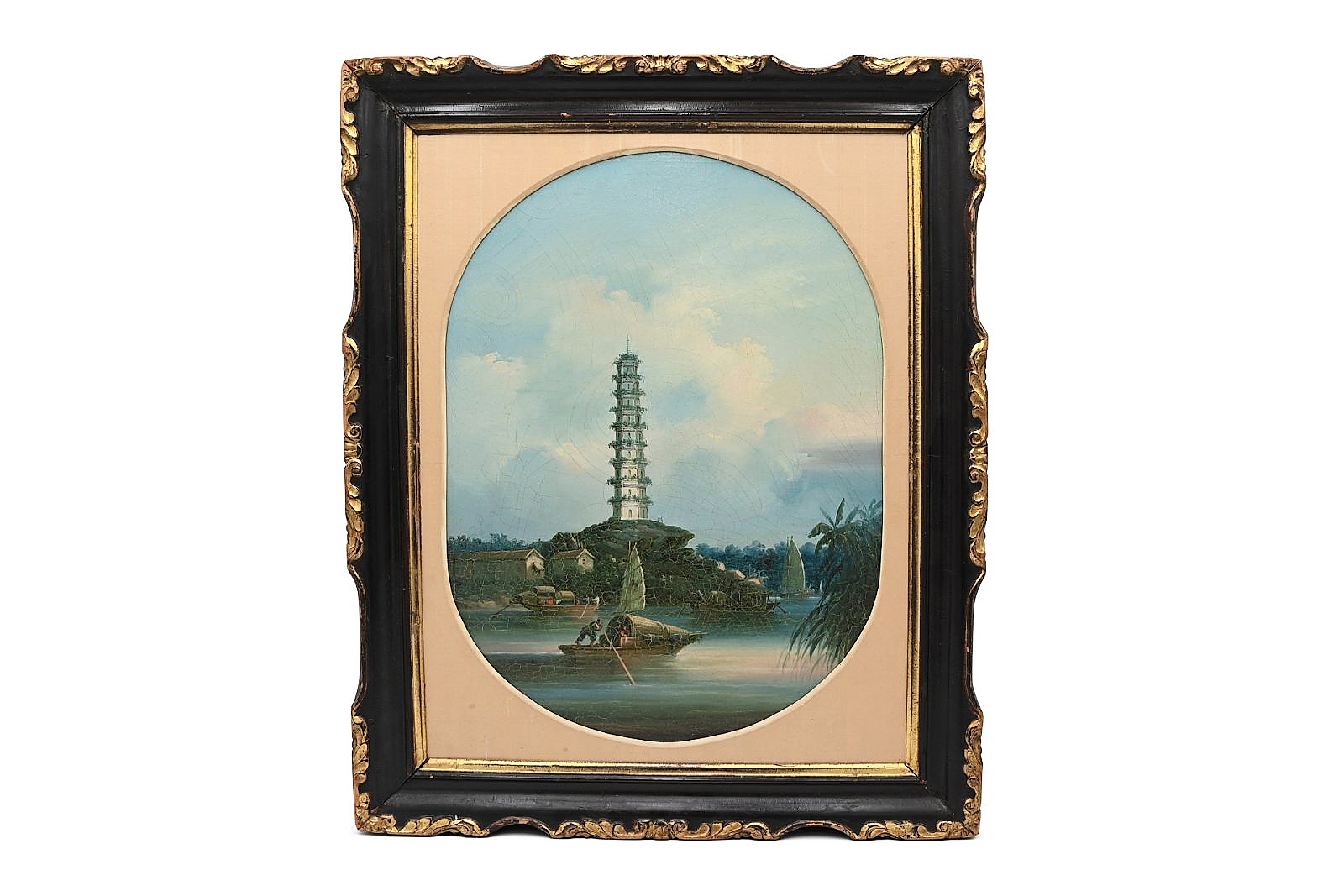
A pair of oil-on-canvas paintings, one showing the Whampoa Pagoda, attributed to Namcheong, sold for $11,000.
More than 20 lots of Chinese export silver included a circa 1820 7-inch-tall covered tea caddy, engraved “In Deo Non Armis Fido,” which sold for $4,000. A presentation silver repousse mug, circa 1850, retailed by Lee Ching sold for $2,750. It was decorated with mounted warriors and inscribed “Given to Capt. John Wood, R.A., by his son Lieut. J.M.B. Wood, H.M., 31st Regt. on his return from The Chinese Expedition Dec. 1863.”
After the sale, Georgina Winthrop, Grogan’s owner and president, said “I think this sale represents what sets us apart and what Grogan does best; bringing to market specialized, single-owner collections of high-quality antiques. We all were able to really immerse ourselves in this collection and present it properly for our consignor. We, literally, had bidders from all over the world. Some were passionate about a particular category — like the Armenian pieces — while others were particularly interested in certain pieces to fill holes in their collections. It was interesting to me to see the depth of interest and the strength of the market. We probably had about 1,000 requests for condition reports, so we really got to talk to a lot of collectors and dealers. In January, we’ll be selling the Kaffel collection, a 40-year collection of Oriental rugs and, between now and then, we’ll be selling fine jewelry and fine art in October and silver and decorative arts in December. It will be a busy few months.”
For information, 617-720-2020 or www.groganco.com. All prices include the buyers’ premium.

























